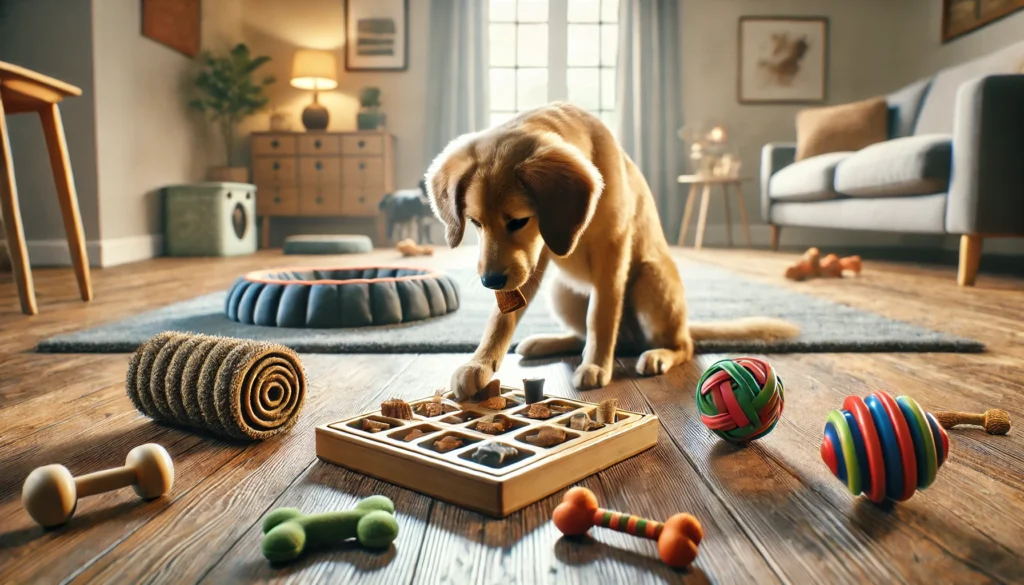Physical exercise is essential for dogs, but what many pet owners forget is that dogs need mental stimulation just as much. When dogs don’t get enough mental activity, they may become anxious, bored, or even destructive indoors. The good news? Mental enrichment can be fun, simple, and incredibly rewarding for both of you.
Let’s explore the signs that your dog is mentally under-stimulated — and how to fix it.
Why Mental Stimulation Matters
Mental activity keeps your dog’s brain engaged and challenged.
- It prevents boredom and the behaviors that come with it
- Helps reduce anxiety and excess energy
- Builds confidence, especially in shy or nervous dogs
- Improves obedience and responsiveness to commands
- Provides fulfillment beyond basic physical needs
When a dog’s mind is busy, they’re more balanced overall.
Common Signs Your Dog Needs More Mental Enrichment
Not sure if your dog is mentally bored? Watch for these behaviors:
1. Destructive Behavior
Chewing furniture, digging at carpets, or tearing up items can signal frustration or boredom.
2. Excessive Barking or Whining
Dogs may vocalize more when they lack stimulation or are craving interaction.
3. Restlessness or Pacing
If your dog seems unable to settle, even after a walk, they may need a mental challenge.
4. Obsessive Behaviors
Constant licking, tail chasing, or shadow watching can be signs of mental underload.
5. Overexcitement or Overreaction
Jumping on guests, zoomies indoors, or difficulty calming down often point to unmet cognitive needs.
6. Sleeping Too Much
While dogs do nap frequently, excessive sleeping may mean your dog has nothing else to do.
7. Ignoring Toys
A lack of interest in toys can happen when they’re too easy, too familiar, or not rotated enough.
How to Add Mental Stimulation to Your Dog’s Day
Now that you’ve identified the signs, here’s what you can do to keep your dog’s brain busy — even indoors.
Rotate Toys Regularly
Dogs get bored with the same toys quickly.
- Keep a toy basket and rotate items every few days
- Choose a mix of chew toys, plush toys, squeaky toys, and interactive ones
- Introduce new toys slowly to keep curiosity high
Variety keeps things fresh and exciting.
Use Puzzle Feeders and Treat Dispensers
Turn mealtime into a thinking game.
- Use store-bought puzzle toys that make your dog work for food
- Try snuffle mats, slow feeders, or Kong toys filled with peanut butter or kibble
- Make your own using household items like muffin tins and tennis balls
Dogs love the challenge and the reward.
Teach New Tricks or Commands
Training is one of the most powerful tools for mental stimulation.
- Practice daily for 5–10 minutes with clear, consistent commands
- Reinforce known tricks and introduce fun ones like “spin,” “touch,” or “crawl”
- Use praise and small treats to keep motivation high
This also improves communication and trust between you and your dog.
Try Nose Work Games
Scent-based games are both stimulating and satisfying.
- Hide treats around the house and let your dog “hunt” for them
- Use cardboard boxes or blankets to conceal food or toys
- Introduce scent games gradually with easy wins to build confidence
This taps into your dog’s natural instincts in a safe, indoor way.
Create Indoor Challenges
Mental exercise can be built into the environment.
- Set up a mini obstacle course using furniture or cushions
- Practice walking through tight spaces or under tables
- Combine obedience with movement (e.g., sit → stay → come → spin)
Be creative and adapt based on your dog’s energy and comfort level.
Let Your Dog Make Choices
Giving your dog control over small decisions helps them feel empowered.
- Offer two toy options and let them choose
- Let them pick the walking route (inside safe limits)
- Allow exploration time in safe, enclosed areas of the home
Even small choices add variety and autonomy to their routine.
Schedule Intentional Engagement
Set aside time each day to connect.
- Play games like tug, hide-and-seek, or fetch (even down a hallway)
- Include quiet time together after stimulating sessions
- Keep interactions positive and varied
Your presence is often your dog’s favorite form of stimulation.
Watch for Progress and Adjust
Dogs respond differently to activities based on age, breed, and personality.
- High-energy breeds may need more frequent challenges
- Senior dogs may enjoy low-impact brain games
- If your dog seems overstimulated, reduce intensity or switch tasks
Balance is key: stimulation should satisfy, not stress.
A Happier Dog Starts With a Busy Mind
Mental stimulation isn’t a luxury — it’s a core part of your dog’s well-being. By recognizing the signs of boredom and offering thoughtful ways to engage their brain, you can prevent negative behaviors and support a more relaxed, content life indoors.
Your dog doesn’t just need something to do. They need something to think about.






